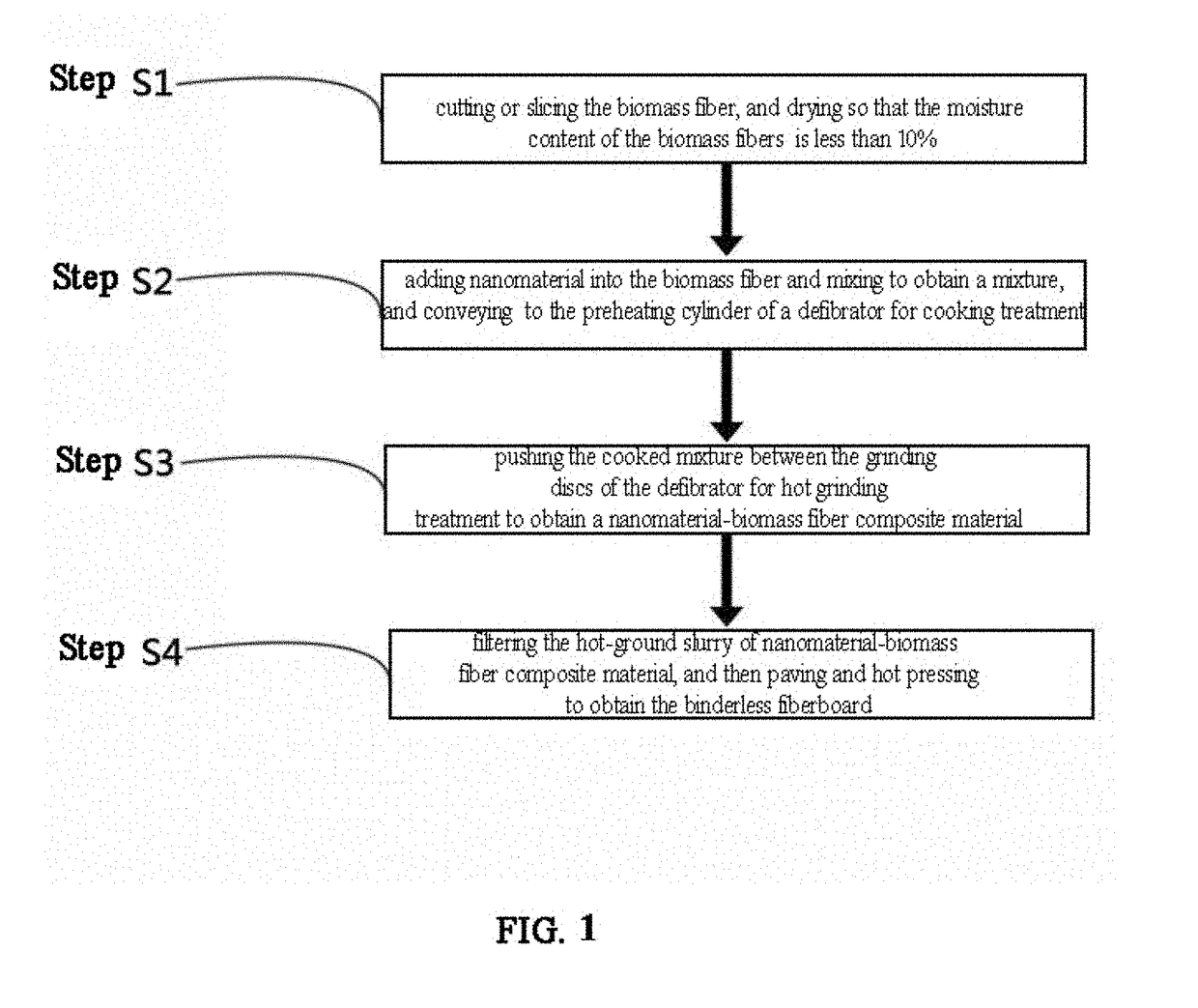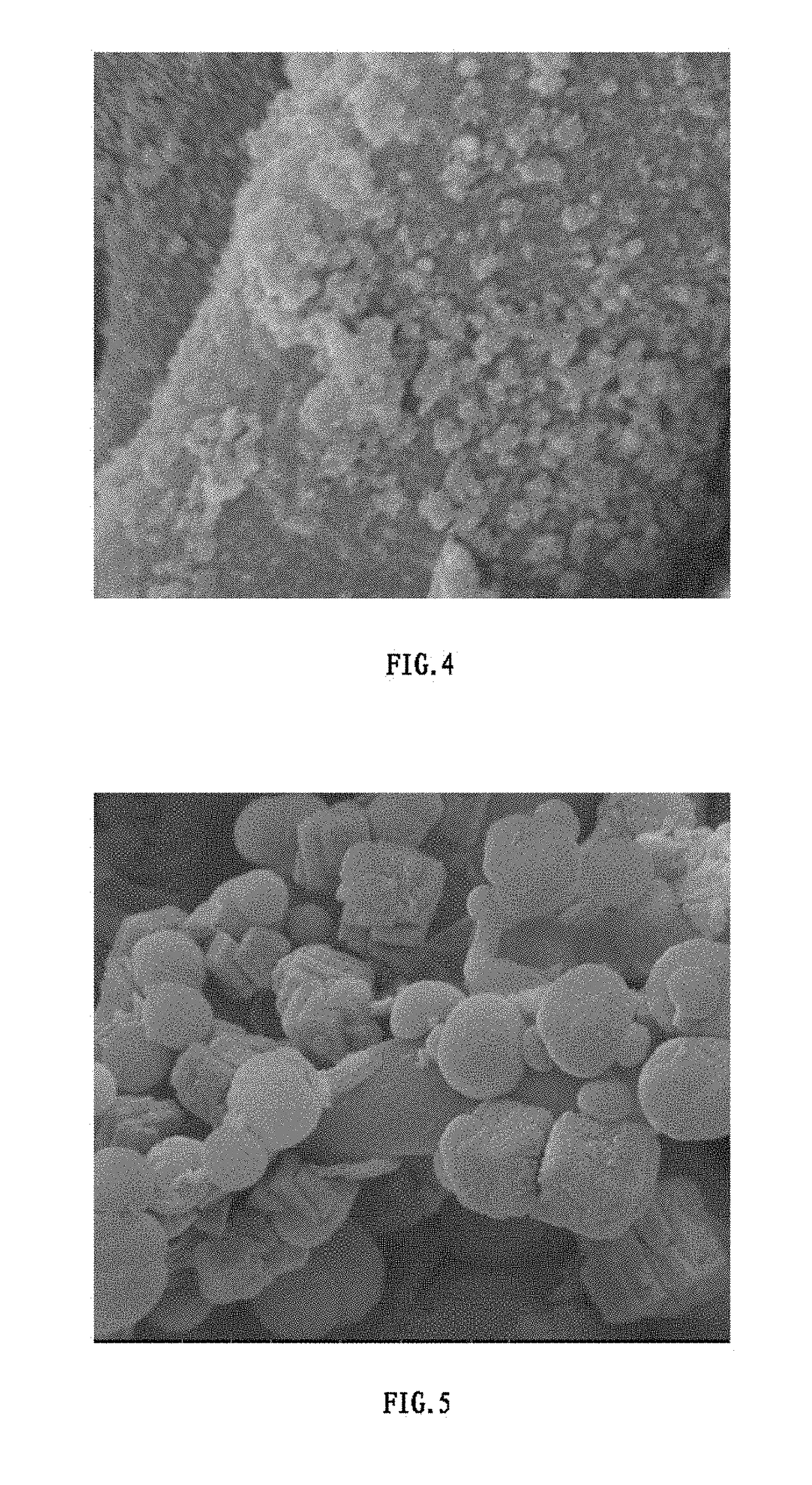Nanomaterial-biomass fiber composite and preparation method thereof
a biomass fiber and nanomaterial technology, applied in the field of composite materials, can solve the problems of low bonding strength, high density, and existing production of binderless fiberboards, and achieve the effect of excellent properties
- Summary
- Abstract
- Description
- Claims
- Application Information
AI Technical Summary
Benefits of technology
Problems solved by technology
Method used
Image
Examples
example 1
[0054]1. Cutting or slicing the biomass fiber, and then drying it to the extent that the moisture content of the biomass fiber is less than 10%, wherein the biomass fiber is wood;
[0055]2. adding nanomaterial into the biomass fiber and mixing them to obtain a mixture, and conveying the mixture to the preheating cylinder of a defibrator for cooking treatment, wherein the cooking temperature in the preheating cylinder is 100° C., the steam pressure is 0.01 MPa and the cooking time is 1 min; the nanomaterial is nano-TiO2, and the nanomaterial accounts for 0.01% of the absolute dry weight of the biomass fiber; and wherein the pH value of the cooked mixture is adjusted to 1 using H3PO4 aqueous solution before carrying out the hot grinding treatment;
[0056]3. pushing the cooked mixture between the grinding discs of the defibrator for hot grinding treatment, wherein the rotating speed for the hot grinding is 2880 rpm, and the time for the hot grinding treatment is 6 h; and
[0057]4. filtering ...
example 2
[0058]1. Cutting or slicing the biomass fiber, and then drying it to the extent that the moisture content of the biomass fiber is less than 10%, wherein the biomass fiber is bamboo;
[0059]2. conveying the nanomaterial to the discharge valve of the defibrator via a pipe and injecting it into the discharge valve via a nozzle so as to be mixed with the biomass fiber to obtain a mixture, and conveying the mixture to the preheating cylinder of the defibrator for cooking treatment, wherein the cooking temperature in the preheating cylinder is 110° C., the steam pressure is 0.02 MPa and the cooking time is 2 min; the nanomaterial is nano-ZnO, and the nanomaterial accounts for 0.02% of the absolute dry weight of the biomass fiber; and wherein the pH value of the cooked mixture is adjusted to 2 using HC1 aqueous solution before carrying out the hot grinding treatment;
[0060]3. pushing the cooked mixture between the grinding discs of the defibrator for hot grinding treatment, wherein the rotati...
example 3
[0062]1. Cutting or slicing the biomass fiber, and then drying it to the extent that the moisture content of the biomass fiber is less than 10%, wherein the biomass fiber is wood and its processing residues;
[0063]2. conveying the nanomaterial onto a wood chip at the feed inlet of the grinding chamber of the defibrator via a delivery pump, conveying it into the continuous discharge valve of the grinding chamber of the defibrator via a gear pump to be mixed with the biomass fiber to obtain a mixture, and conveying the mixture to the preheating cylinder of the defibrator for cooking treatment, wherein the cooking temperature in the preheating cylinder is 120° C., the steam pressure is 0.05 MPa and the cooking time is 4 min; the nanomaterial is nano-Ag, and the nanomaterial accounts for 0.04% of the absolute dry weight of the biomass fiber; and wherein the pH value of the cooked mixture is adjusted to 3 using H2SO4 aqueous solution before carrying out the hot grinding treatment;
[0064]3....
PUM
| Property | Measurement | Unit |
|---|---|---|
| Temperature | aaaaa | aaaaa |
| Temperature | aaaaa | aaaaa |
| Fraction | aaaaa | aaaaa |
Abstract
Description
Claims
Application Information
 Login to View More
Login to View More - R&D
- Intellectual Property
- Life Sciences
- Materials
- Tech Scout
- Unparalleled Data Quality
- Higher Quality Content
- 60% Fewer Hallucinations
Browse by: Latest US Patents, China's latest patents, Technical Efficacy Thesaurus, Application Domain, Technology Topic, Popular Technical Reports.
© 2025 PatSnap. All rights reserved.Legal|Privacy policy|Modern Slavery Act Transparency Statement|Sitemap|About US| Contact US: help@patsnap.com



